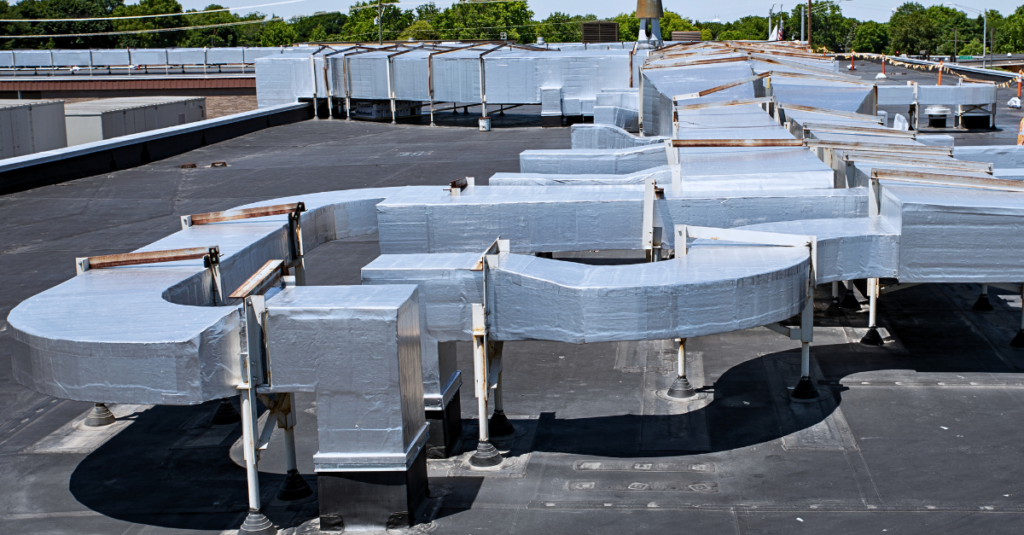Of all considerations regarding heating, ventilation, and air conditioning (HVAC) systems, duct insulation sophistication is one of the important features for efficiency. Like other insulators, fiberglass and foam help maintain temperature, but duct cladding installation is equally important. This outer protective covering enhances the efficiency of HVAC duct insulation by reducing heat deterioration, stabilizes insulation from moisture and physical damage, and increases energy efficiency.
As a coat of armor preserves a warrior from various adversities such as severe temperature and climatic conditions, so does duct cladding preserve insulation. This helps maintain the integrity of the insulation which slows down energy consumption and captures air emissions. Duct cladding is known for preservation and as a duct insulating feature and hot places like Riyadh would benefit from this because it prevents external warm air from getting into the ducts and neutralizing the cool air within.
Through duct cladding, disassembling an HVAC system becomes less frequent while extending the lifespan of the entire system since insulation is less subject to damage. This leads to less repairs and replacements while having more efficient system performance. This is why in this blog post we will look at duct cladding installation and how far it can improve HVAC duct insulation, reduce energy cost, and increase the effectiveness of the system overall.
What is Duct Cladding?
Duct cladding is a form of construction wooden casing for air ducts applied for the purposes of shielding the internal duct insulation from moisture, physical alteration, UV light and harsh weather. The industry’s staples in cladding materials consist of aluminum, PVC, as well as galvanized steel based upon their marketing cut and the climate requirements. When applied duct cladding helps improve the duct insulation’s structural integrity by preserving its functionality and preventing its decomposition long term.
Duct insulation’s primary purpose is prevention of interference in the systems air heat transfer processes, while putting in place air temperature control measures. Duct cladding installation is a second level of intervention that prevents air from escaping the ducts by providing additional insulation support. Furthermore, the outer cover board enhances the overall strength and durability of a HVAC system, reclosing the thermal benefits.
How Does Duct Cladding Installation Improve HVAC Duct Insulation?

The main goal of duct cladding installation is to enhance the performance of duct insulation, ensuring that it works at its full potential. Whether you’re dealing with pre-insulated ducts, flexible ducts, or traditional ducts, cladding significantly boosts their energy efficiency and insulation properties.
Temperature Regulation:
The cladding ensures that the duct insulation remains intact by protecting it from environmental factors. For instance, in extreme temperatures—whether hot or cold—duct cladding installation helps preserve the insulation’s ability to prevent heat loss in winter or heat gain in summer, ensuring that the air moving through the ducts stays at the right temperature when it reaches each room. This is particularly important in places like Riyadh, where the temperature fluctuations between day and night can be extreme.
Moisture Prevention:
In high humidity environments, moisture can be harmful to duct insulation. The duct cladding installation acts as a moisture barrier which prevents water from seeping into the duct insulation and damaging it over time. This feature is very important to systems that utilize flexible ducts because those are more likely to get damaged by moisture..
Physical Protection:
No doubt, changing the moisture to suppressing gas ratio captures the interest of duct insulation operatives because of the apathy and violence sculptured by rough dealing. Irrespective of being climatic related disintegration or external damages, duct cladding offers additional level of protection. This additional level of protection extends to the safeguarding of duct insulation against the impact, abrasion and any other extensive physical forces which could critically damage the insulation’s efficacy.
Durability:
Duct cladding installation not only helps protect the insulation but also extends the overall lifespan of your HVAC system. By preventing the insulation from breaking down prematurely, cladding helps keep the system operating efficiently for years, reducing the need for frequent repairs or replacements.
Aesthetic and Professional Finish:
Apart from the operational advantages, duct cladding contributes to an elegant presentation of HVAC systems. This is rather critical in commercial facilities or buildings where aesthetic and visual appeal is a priority. The smooth finishing that cladding provides enhances the general appearance of your ductwork and contributes to a more pleasant setting.
Why Duct Cladding Matters in HVAC Systems
Role of Duct Insulation in Temperature Regulation
Duct insulation helps keep the air inside the ducts at the right temperature as it moves through the system. Without it, hot or cool air would lose its intended temperature due to environmental exposure. Proper duct cladding installation acts as a barrier, shielding ducts from heat exchange and minimizing thermal losses.
Impact on Energy Efficiency and Cost Savings
Insulated and covered ducts help your HVAC system work less hard. When your system doesn’t have to work hard to keep the right temperature, your energy bills go down. Studies suggest that efficient HVAC duct insulation can cut energy costs by up to 30%, making it a smart investment for both residential and industrial setups.
Benefits of Duct Cladding Installation

Let’s break down the significant advantages that come with duct cladding installation:
Improved Energy Efficiency: By providing an added layer of protection for your duct insulation, duct cladding helps maintain the desired air temperature within the ductwork. This results in less energy being required to heat or cool the air, making your HVAC system more energy-efficient. Whether you have pre-insulated ducts or standard ductwork, the cladding ensures that the system performs optimally without unnecessary energy waste.
Cost Savings: Because duct cladding installation improves energy efficiency, it directly contributes to lowering your utility bills. In addition, the protection it offers the insulation leads to fewer repairs or replacements, which saves on long-term maintenance costs.
Reduced Heat Loss/Gain: One of the primary benefits of duct cladding is its ability to minimize the amount of heat that escapes or enters through the ducts. This is crucial for maintaining the desired temperature indoors, especially in hot climates like Riyadh, where excessive heat gain in air conditioning ducts can reduce the system’s cooling efficiency.
Improved Indoor Air Quality: Apart from the operational advantages, duct cladding contributes to an elegant presentation of HVAC systems. This is rather critical in commercial facilities or buildings where aesthetic and visual appeal is a priority. The smooth finishing that cladding provides enhances the general appearance of your ductwork and contributes to a more pleasant setting.
Long-Term Performance: The added layer of protection from duct cladding ensures that your HVAC system performs at its best over the long term. Without the degradation of insulation services your system runs more efficiently, saving you money on repairs and energy costs.
Why Choose Airlution for Duct Cladding Installation in Riyadh?
Airlution is your reliable partner when it comes to duct cladding installation and HVAC duct insulation in Riyadh. Our expert team provides professional grade insulation services customized to each client’s HVAC requirements. We cater to all of your needs from flexible duct insulation, pre-insulated ducts, to high-performance thermal insulation – whatever the case is, we offer multiple options.
Airlution takes pride in fully understanding Riyadh’s unique climate challenges. We specialize in duct cladding installation which enhances energy efficiency and contributes to indoor comfort. Our team ensures peak performance of the HVAC system for cost savings and enhanced system health over time. Leave all duct cladding installation in Riyadh to Airlution and experience professionalism at its peak.
Conclusion
Incorporating duct cladding into your HVAC system is a wise decision considering the numerous advantages it provides. It enhances the quality of duct insulation and elevates the energy efficiency of the HVAC system. Cladding protects insulation from damage, moisture and other external factors, which increases the performance of the system.
With the duct cladding installation, there is reduced energy wastage which also translates to low energy costs and a pleasant indoor atmosphere. Cladding helps in expanding the system’s duct efficiency regardless of whether it is a new installation or an upgrade to the existing ducts, thus saving more money while also prolonging the lifespan of the system.
Airlution gives duct cladding and HVAC insulation services in Riyadh. Our qualified professionals guarantee system optimization while improving energy efficiency, providing reliable service for service you can trust.
Contact us today to improve your HVAC system—let Airlution help you get the most out of your HVAC performance.
FAQs
1. What is duct cladding and why is it important?
Duct cladding is a cover placed on the outside of HVAC ducts. It stops energy loss, protects the ducts from damage, and helps the system work better.
2. How does duct cladding improve HVAC performance?
It reduces heat transfer, prevents condensation, and ensures that air reaches its destination at the desired temperature.
3. What materials are used in duct cladding?
Common materials include fiberglass, polyurethane foam, and aluminum sheets, often found in pre-insulated ducts.
4. How often should duct cladding be inspected?
You should inspect it every 6 months or after any renovation work that may affect ductwork.
5. Can I install duct cladding myself?
While possible for small projects, professional installation is recommended for larger systems to ensure proper sealing and insulation.
6. Is duct cladding suitable for all climates?
Yes, but the type of thermal insulation should be chosen based on local temperature and humidity levels.


